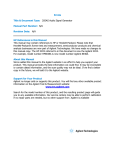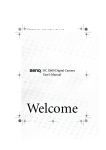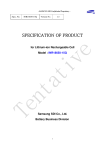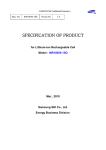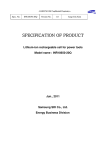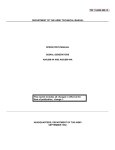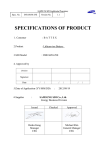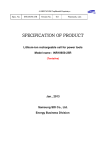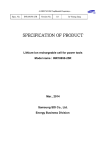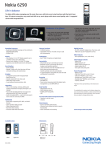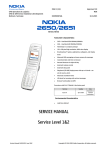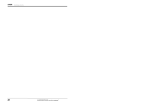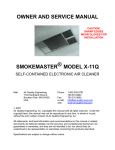Download Revision History - Master Instruments
Transcript
-SAMSUNG SDI Confidential Proprietary –
Spec. No.
IFR18650-11Q
Version No.
1.1
Peter Kim, Lucy Kim
Revision History
Revision
No.
Revision date
1.0
Sept 27, 2010
1.1
Oct 14, 2010
Page
Item
Description
Formulated first edition
3.8, 7.6,7.8
2
Max Charge Current
Remark
-SAMSUNG SDI Confidential Proprietary –
Spec. No.
IFR18650-11Q
Version No.
1.1
Peter Kim, Lucy Kim
1. Scope
This product specification has been prepared to specify the rechargeable lithium-ion cell
('cell') to be supplied to the customer by Samsung SDI Co., Ltd.
2. Description and model
2.1 Description
lithium-ion rechargeable cell
2.2 Model
IFR18650-11Q
3. Nominal Specifications
Item
Specification
3.1 Nominal discharge capacity
1100mAh (220mA, 2.0V discharge)
3.2 Standard discharge capacity
≥ 950mAh (10A, 2.0V discharge)
3.6 ±0.1V
3.3 Charging voltage
Deviation from 3.6V: Possible decrease in capacity
&/or cycle life
3.4 Nominal voltage
3.2V
(derived using EPTA Method)
3.5 Charging method
CC-CV with 50mA cut-off
3.6 Charging current
Standard charge: 550mA
Alternately CC – Step CC is acceptable
Standard charge: 150min
Rapid(Max.) charge : 50min
3.8 Maximum charge current
1.5 A (ambient temperature 25oC, 1000cycle)
(Charge current that will result in nominal cycle life
3.0 A (ambient temperature 25oC, min.
performance as described in 7.8-1 of > 1000
500cycle)
cycles.)
3.9 Max. discharge current
(Continuous discharge current that will result in
10A
nominal cycle life performance as described in
3.7 Charging time
7.8-1 of > 1000 cycles.)
2.0V for cycle life
3.10 Discharge cut-off voltage
(Cutoff voltage may be set to 0.5V but it may cause
deterioration in cell performance.)
3.11 Cell weight
40.0±3.0 g
3.12 Cell dimension
Diameter : Φ18.15±0.1 mm
Height : 64.80±0.15 mm
3.13 Operating temperature
Charge: 5 to 45 oC
Discharge: -10 to 60 oC
(Ambient temperature)
3.14 Cell temperature
Charge: 0 to 60 oC
Discharge: -20 to 80 oC
3.15 Storage temperature
18months:-20~25oC(1*)
3months:25~45oC(1*)
(Suggested)
3
-SAMSUNG SDI Confidential Proprietary –
Spec. No.
IFR18650-11Q
Version No.
1.1
Peter Kim, Lucy Kim
1month :45~60oC(1*)
4. Outline dimensions
See the attachment (Fig. 1)
5. Appearance
There shall be no such defects as scratch, rust, discoloration, or leakage which
may adversely affect commercial value of the cell. Any uncertainty arising out of the
previous phrase shall be settled upon between consultation between both Black & Decker
and Samsung.
5.1 Cell Sleeve Material
Cell sleeve material should maintain electrical insulation properties (i.e. not deform or
shrink to expose cell can along longitudinal (length) direction) after storage for 2 hours at
150 oC.
6. Standard test conditions
6.1 Environmental conditions
Unless otherwise specified, all tests stated in this specification are conducted at
temperature 25±5 oC and humidity 65±20%.
6.2 Measuring equipment
(1) Ammeter and voltmeter
The ammeter and voltmeter should have an accuracy of the grade 0.5 or higher.
(2) Slide caliper
The slide caliper should have 0.01 mm scale.
(3) Impedance meter
The impedance meter with AC 1kHz should be used.
7. Characteristics
7.1 Standard charge
This "Standard Charge" means charging the cell with charge current
0.55A and constant voltage 3.6V 50mA cut-off at 25 oC.
7.2 Standard discharge capacity
The standard discharge capacity is the initial discharge capacity of the cell, which is
measured with discharge current of 10A with 2.0V cut-off at 25 oC within 1hour
after the standard charge.
Standard Discharge Capacity
≥ 950mAh
7.3 Initial internal impedance
Initial internal impedance measured at AC 1kHz after standard charge.
Initial internal impedance
15.5 ±3.5mΩ*
*Tentative spec.: Specification can be changed by mutual agreement on request of
either
party
7.4 Temperature dependence of discharge capacity
4
-SAMSUNG SDI Confidential Proprietary –
Spec. No.
IFR18650-11Q
Version No.
1.1
Peter Kim, Lucy Kim
Capacity comparison at each temperature, measured with discharge
constant current 10A and 2.0V cut-off after the standard discharge is
as follows.
Discharge temperature
o
-10 C
0 oC
25 oC
60 oC
75%
80%
100%
100%
Note: If charge temperature and discharge temperature are not the same,
the interval for temperature change is 3 hours.
Percentage as an index of the capacity at 25 oC (=950mAh) is 100%.
7.5 Temperature dependence of charge capacity
Capacity comparison at each temperature, measured with discharge constant current
10A and 2.0V cut-off after the standard charge is as follows.
Charge temperature
Relative Capacity
5 oC
25 oC
45 oC
80%
100%
95%
Discharge temperature
25 oC
Note: If charge temperature and discharge temperature is not the same, the interval for
temperature change is 3 hours.
Percentage as an index of the capacity at 25oC (=950mAh) is 100%
.
7.6 Charge rate capabilities
Discharge capacity is measured with constant current 10A and 2.0V cut-off
after the cell is charged to 3.6V as follows.
Charge Condition
Current
0.55A
Rapid 3.0A
Cut-off
50mA
50mA
Relative
100%
98%
Capacity
o
Note: Percentage as an index of the capacity at 25 C and 0.55A charging
(=950mAh) is 100%.
7.7 Discharge rate capabilities
Discharge capacity is measured with the various currents in table and 2.0V
cut-off after the standard charge.
5
-SAMSUNG SDI Confidential Proprietary –
Spec. No.
IFR18650-11Q
Version No.
1.1
Peter Kim, Lucy Kim
Discharge Condition
Current
1.1A
5A
10A
20A
30A
Relative
103%
101%
100%
98%
95%
Capacity
o
Note: Percentage as an index of the capacity at 25 C (=950mAh) is 100%.
7.8 Cycle life
7.8.1
Each cycle is an interval between the charge (charge current 1.5A) with 50mA cut-off
and the discharge (discharge current 10A) with 2.0V cut-off.
Capacity after 1000cycles,
Capacity ≥ 710mAh (75% of the standard capacity at 25 oC)
7.8.2
Each cycle is an interval between the charge (charge current 3.0A) with 50mA cut-off
and the discharge (discharge current 10A) with 2.0V cut-off.
Capacity after minimum 500cycles,
Capacity ≥ 830mAh (87.5% of the standard capacity at 25 oC)
7.9 Storage characteristics
Capacity after storage for 1 month at 60 oC from the standard charge,
measured with discharge current 10A with 2.0V cut-off at 25 oC.
Capacity recovery (after the storage) ≥ 760mAh (80% of the capacity at 25 oC)
7.10 Status of the cell as of ex-factory
The cell should be shipped as requested by a customer
7.10.1 Hard Limit*: 3270±15 mV (~30 days)
≥3250 mV (~90 days)
≥3240 mV (~180 days)
.
7.10.2 All cells in a given pack are to be in the soft limit.
Soft limit*: ≤ 9mV (Max-Min)
*Tentative spec.: Specification can be changed by mutual agreement on request of
either
party
6
-SAMSUNG SDI Confidential Proprietary –
Spec. No.
IFR18650-11Q
Version No.
1.1
Peter Kim, Lucy Kim
8. Mechanical Characteristics
8.1 UN test
Test method: UN Manual of Tests & Criteria Part III, Subsection 38.3.4.1~8.
Criteria: Pass
8.2 Vibration test
1) Cell is tested as received.
2) Measure OCV and ACR.
3) Test is conducted at room temperature.
4) Cells held firmly and are tested in both
horizontal and vertical orientations.
5) Random vibration conducted for 3 hours
minimum with the following profile:
Frequency
(HZ)
20
Amplitude
(G^2/HZ)
0.04997
55
0.1956
350
0.1956
1000
0.06988
The OCV and ACR
are to be
measured after a
24 hour rest.
0.25
0.20
0.15
0.10
0.05
0.00
10
100
Frequency (HZ)
7
No leakage.
No venting.
ACR shall not
change by > +/- 2
mOhm
OCV shall not
change by > +/
1%
Random Vibration Profile
Amplitude (G^2/Hz)
Vibration
1000
-SAMSUNG SDI Confidential Proprietary –
Spec. No.
IFR18650-11Q
Version No.
1.1
Peter Kim, Lucy Kim
9. Safety
9.1 Overcharge test
Test method: To charge with 3A to 34V at 25 oC for 2hr.
Criteria: No fire, and no explosion.
9.2 External short-circuit test
Test method: To short-circuit the standard charged cell (or 50% discharged cell)
by connecting positive and negative terminal by less than or = 5mΩ wire for 10min.
Criteria: No fire, and no explosion.
9.3 Forced discharge test
Test method: To discharge the discharged cell (0% charged) with charge current 1.1A
by -12V for 1 hour.
Criteria: No fire, and no explosion within 7 days.
9.4 Heating test
Test method: To heat up the standard charged cell at heating rate 5 oC per minute up to
150 oC and keep the cell in oven for 1hr.
Criteria: No fire, and no explosion.
10. Warranty
Samsung SDI will be responsible for replacing the cell against defects or poor
workmanship for 18months from the date of shipping. Any other problem caused by
malfunction of the equipment or misuse of the cell is not covered under this warranty. The
warranty set forth with proper use and handling conditions described above and excludes
cases of defects which are not related to manufacturing of the cell.
11. Others
11.1 Long-term storage
If the cell is kept for a long time (3months or more), it is strongly recommended
that the cell is preserved at dry and low-temperature.
11.2 Other
Any matter not called for in the specifications should be conferred with
between both parties (Black and Decker and Samsung.)
12. ECN(Engineering Change Notice) of Product
Any change, which is related to cell chemistry, construction, material, or process shall be
approved by Customer.
8
-SAMSUNG SDI Confidential Proprietary –
Spec. No.
IFR18650-11Q
Version No.
1.1
Peter Kim, Lucy Kim
13. Packing
See Fig.2,
Package Drawing
Φ18.15±0.1
64.80±0.15
Unit: mm
Fig.1. Outline dimensions of IFR18650-11Q
9
-SAMSUNG SDI Confidential Proprietary –
Spec. No.
IFR18650-11Q
Version No.
1.1
Tape
Fig.2. Package drawing
10
Peter Kim, Lucy Kim
-SAMSUNG SDI Confidential Proprietary –
Spec. No.
IFR18650-11Q
Version No.
1.1
Peter Kim, Lucy Kim
Proper use and handling of lithium ion cells
See before using lithium-ion cell
Supplied by
Samsung SDI Co., Ltd.
1. General
This document has been prepared to describe the appropriate cautions and
prohibitions, which the customer should take or employ when the customer uses
and handles the lithium ion cell to be manufactured and supplied by Samsung SDI Co.,
Ltd., in order to obtain optimum performance and safety.
2. Charging
2.1 Charging current
Charging current shall be less than or equal too maximum charge current specified in
the product specification.
2.2 Charging voltage
Charging voltage shall be less than or equal to that specified in the product specification.
2.3 Charging time
Continuous charging under appropriate voltage does not cause any loss of
characteristics. It is recommended that a time-out timer function be incorporated in the
charging system to suspend charging past a given time.
2.4 Charging temperature
The cell shall be charged within a range of specified temperatures in
the product specification.
2.5 Reverse charging
The cell shall be connected, confirming that its poles are correctly aligned.
Inverse charging should be strictly prohibited. If the cell is connected
improperly, it may be damaged.
3. Discharging
3.1 Discharging
3.1.1 The cell should be discharged continuously at less than maximum discharge
current specified in the product spec. The cell may be continuously discharged at
a higher rate but with degradation of performance to be expected.
3.2 Discharging temperature
3.2.1 The cell shall be discharged within a range of temperatures specified in
the product specification otherwise it may cause loss of characteristics.
3.3 Over-discharging
3.3.1 The system should be equipped with a device to prevent discharge
exceeding discharging cut-off voltage specified in the product
specification. (over-discharging)
3.3.2 Over-discharging may cause loss of performance, characteristics and
11
-SAMSUNG SDI Confidential Proprietary –
Spec. No.
IFR18650-11Q
Version No.
1.1
Peter Kim, Lucy Kim
cell function.
3.3.3 Over-discharging may occur by self-discharge if the cell is left for
a very long time without any use.
3.3.4 The charging system should be equipped with a device to detect voltage of each
cell block to determine recharging procedures.
4. Storage
4.1 Storage conditions
4.1.1 The cell should be stored within a range of temperatures specified
in the product specification. Otherwise, it may cause loss of characteristics,
leakage and/or rust.
4.2 Long-term storage
4.2.1 The cell should be used within a short period after charging because
long-term storage may cause loss of capacity by self-discharging.
4.2.2. If long-term storage is necessary, the cell should be stored at lower
voltage within a range specified in the product specification, because
storage with higher voltage may cause more loss of characteristics.
5. Cycle life
5.1 Cycle life performance
5.1.1 The cell can be charged/discharged repeatedly up to times specified in
the product specification with a certain level of capacity specified in the
product specification.
5.1.2 Cycle life may be affected by conditions of charging, discharging,
operating temperature, and/or storage.
6. Design of system
6.1 Connection between the cell and the battery
6.1 The cell should not be soldered directly with other cells. Namely, the cell
should be welded with leads on its terminal and then be soldered with
wire or leads otherwise, it may cause damage of cell components, such as
separator and insulator, by heat generation.
6.2 Positioning the battery in the system
6.2.1 The battery should be positioned as possible as far from heat sources high
temperature components otherwise, it may cause loss of characteristics.
6.2.3 The recommended spacing between the cells is more than 1mm.
6.3 External shock protection of the cell
6.3.1 The cells in the pack should be mechanically constrained and not loose in order to
minimize movement by external shock.
6.4 Short-circuit protection of the cell
6.4.1 The cell should be equipped with an insulating sleeve to protect against a
12
-SAMSUNG SDI Confidential Proprietary –
Spec. No.
IFR18650-11Q
Version No.
1.1
Peter Kim, Lucy Kim
short-circuit event which may occur during transportation, battery assembly, and
/or system operation.
6.4.2 If the cell sleeve is damaged by some cause such as outside impact,
this may cause short-circuit with some wiring inside the battery.
6.5 Connection between the battery and charger/system
6.5.1 The battery should be designed to be connected only to the specified
charger and system.
6.5.2 A reverse connection of the battery, even in the specified system, should be
avoided by employing special battery design such as special terminals.
6.6 Pack design
6.6.1 For best performance, the current consumption of the battery pack should be less
than 10uA (1P cell configuration) at sleep mode.
6.6.2 Cell Voltage monitoring system.
The system (Charger or Pack) should be equipped with a device to monitor the
voltage of each of cell block and stop charging if max voltage threshold is
reached.
6.6.4 The system should suspend operation if a condition such as over temperature,
over voltage, or over current, is detected.
7. Battery pack assembly
7.1 Prohibition of usage of damaged cell
7.1.1 The cell should be inspected visually before battery assembly.
7.1.2 The cell should not be used if sleeve-damage, can-distortion, or electrolyte-smell
is detected.
7.2 Terminals handling
7.2.1 Excessive force on the negative terminal should be avoided when external lead is
welded.
7.3 Transportation
7.3.1 Careful precautions should be taken during transportation of the cell (for example
to the battery pack manufacturer, to avoid damage to the cell.
8. Others
8.1 Disassembly
8.1.1 The cell should not be dismantled from the battery pack.
8.1.2 Internal short-circuit caused by disassembly may lead to heat generation or
venting.
8.1.3 If electrolyte comes into contact with the skin or eyes, flush immediately with fresh
water and seek medical advice.
13
-SAMSUNG SDI Confidential Proprietary –
Spec. No.
IFR18650-11Q
Version No.
1.1
Peter Kim, Lucy Kim
8.2 Short-circuiting
8.2.1 Short-circuit results in very high current which leads to heat generation.
8.2.2 An appropriate circuit should be employed to protect accidental short-circuiting.
8.3 Incineration
8.3.1 Incinerating and disposing of the cell in fire are strictly prohibited, because it may
cause rupture and explosion.
8.4 Immersion
8.4.1 Soaking the cell in water is strictly prohibited, because it may cause corrosion
and leakage and cell components to be damaged.
8.5 Mixing use
8.5.1 Mixing different types of cells or same types by different manufactures shall not
be done. Doing so may lead to cell imbalance, cell rupture, or damage to the
system due to different characteristics of the cells.
8.6 Battery exchange
8.6.1 Although the cell contains no environmentally hazardous component,
such as lead or cadmium, the battery shall be disposed according to
the local regulations.
8.6.2 It is recommended that the cell be disposed in a discharged state.
8.7 Caution
The Battery used in this device may present a risk of fire or chemical burn if
mistreated.
Do not disassemble, expose to heat above 100 oC or incinerate it.
Replace battery with those of Samsung SDI only.
Use of another battery may cause a risk of fire or explosion.
Dispose of used battery promptly.
Keep battery away from children.
Do not disassemble and do not dispose of battery in fire.
8.8 Warning – Attached
Handling precaution and prohibitions of lithium Ion & lithium Ion polymer
14
-SAMSUNG SDI Confidential Proprietary –
Spec. No.
IFR18650-11Q
Version No.
1.1
Peter Kim, Lucy Kim
rechargeable cells and batteries
Inaccurate handling of lithium ion and lithium ion polymer rechargeable battery may cause leakage, heat,
smoke, explosion, or fire. This could cause deterioration of performance or failure. Please be sure to
follow instructions carefully.
1.1 Storage
Store the battery at low temperature (below 25 oC is recommended), low humidity, no dust and no
corrosive gas atmosphere.
1.2 Safety precaution and prohibitions
To assure product safety, describe the following precautions in the instruction manual of the
application.
[Danger!]
■ Electrical misusage
Use stipulated charger.
Use or charge the battery only in the stipulated application.
Don't charge the battery by an electric outlet directly.
Don't charge the battery reversely.
■ Environmental misusage
Don't leave the battery near fire or a heat source.
Don't throw the battery into a fire.
Don't store, charge, or use the battery under continuous conditions of over 60 oC ambient
temperatures.
Don't immerse, throw, or wet the battery in water / seawater.
■ Others
Don't crush the battery.
Don’t store the battery in a pocket or a bag with metallic objects such as keys, necklaces, hairpins,
coins, or screws unless mechanical or electrical countermeasures are in place to prevent shorting of
the cells.
Don't short circuit (+) and (-) terminals with metallic object intentionally.
Don't pierce the battery with a sharp object such as a needle, screw drivers.
Don't heat partial area of the battery with heated objects such as soldering iron.
Don’t intentionally hit with heavy objects such as a hammer or weight.
15
-SAMSUNG SDI Confidential Proprietary –
Spec. No.
IFR18650-11Q
Version No.
1.1
Peter Kim, Lucy Kim
Don't step on the battery and throw or drop the battery on the hard floor to avoid mechanical shock.
Don't disassemble the battery or modify the battery design including electric circuit.
Don't solder on the battery directly.
Don't use seriously scared or deformed battery.
Don't put the battery into a microwave oven, dryer ,or high-pressure container.
Don't use or assemble the battery with other makers' batteries, different types and/or models of
batteries such as dry batteries, nickel-metal hydride batteries, or nickel-cadmium batteries.
Don't use or assemble old and new batteries together.
[Warning!]
Stop charging the battery if charging isn't completed within the specified time.
Stop using the battery if the battery becomes abnormally hot, order, discoloration, deformation, or
abnormal conditions is detected during use, charge, or storage.
Keep away from fire immediately when leakage or foul odors are detected. If liquid leaks onto your
skin or cloths, wash well with fresh water immediately.
If liquid leaking from the battery gets into your eyes, don't rub your eyes and wash them with clean
water and go to see a doctor immediately.
If the terminals of the battery become dirty, wipe with a dry cloth before using the battery.
The battery can be used within the following cell surface temperature ranges. Don't exceed these
ranges.
Charge temperature ranges
: 0oC ~ 60 oC
Discharge Temperature ranges : -20 oC ~ 80 oC
Store the battery at temperature below 60 oC
Cover terminals with proper insulating tape before disposal.
[Caution!]
■ Electrical misusage
Battery must be charged with method agreed to by both parties (Black & Decker and Samsung.)
Charge current must be controlled by specified value in cell specification.
Cut-off voltage of charging must be equal to or less than 3.6V +/- 0.1 V to achieve best cycle life
performance.
Do not discharge battery in an inappropriate way.
Cut-off voltage of full discharging and recharging must be over 2.0V to achieve best cycle life
performance.
■ Others
16
-SAMSUNG SDI Confidential Proprietary –
Spec. No.
IFR18650-11Q
Version No.
1.1
Peter Kim, Lucy Kim
Keep the battery away from babies and children to avoid any accidents such as swallow.
If younger children use the battery, their guardians should explain the proper handling method and
precaution before using.
Before using the battery, be sure to read the user's manual and precaution of it's handling.
Before using charger, be sure to read the user's manual of the charger.
Before installing and removing the battery from application, be sure to read user's manual of the
application.
It is recommended to replace the battery when the use time becomes much shorter than usual.
It is recommended to cover the terminals with insulating tape before disposal.
If the battery is needed to be stored for an long period, battery should be removed from the
application and stored in a place where humidity and temperature are low.
While the battery is charged, used and stored, keep it away from object materials with static electric
charges.
Safety handling procedure for the transporter
■ Quarantine
Packages that are crushed, punctured or torn open to reveal contents should not be
transported. Such packages should be isolated until the shipper has been consulted,
provided instructions and, if appropriate, arranged to have the product inspected and
repacked.
■ Spilled product
In the event that damage to packaging results in the release of cells or batteries,
the spilled products should be promptly collected and segregated and the shipper
should contact for instructions.
Design of positioning the battery pack in application and charger
To prevent the deterioration of the battery performance caused by heat, battery shall be positioned
away from the area where heat is generated in the application and the charger.
Design of the battery pack
If you intend to adopt any device that will be electrically contacting the cell in the battery pack, please
contact Samsung SDI to investigate any potential safety problems.
Multiple protection methods should be employed to prevent safety problems.
Please contact following offices when you need any help including safety concerns.
17
-SAMSUNG SDI Confidential Proprietary –
Spec. No.
IFR18650-11Q
Version No.
1.1
Peter Kim, Lucy Kim
Samsung SDI emergency contact information
■ Samsung SDI Cheonan factory QA
508, Sungsung-dong, Cheonan-si, Chungnam, Korea
Tel:(+82)070-7125-1837 Fax:(+82)41-560-3697
■ Samsung SDI America office.
18600 Broadwick Street Rancho Dominguez CA 90220
Tel:(+1)310-900-5205 Fax:(+1)310-537-1033
■ Samsung SDI Taiwan office.
Rm. 3010, 30F., 333, Keelung Rd. Sec. 1, Taipei, Taiwan
Tel:(+886)2-2728-8469 Fax:(+886)2-2728-8480
18

















